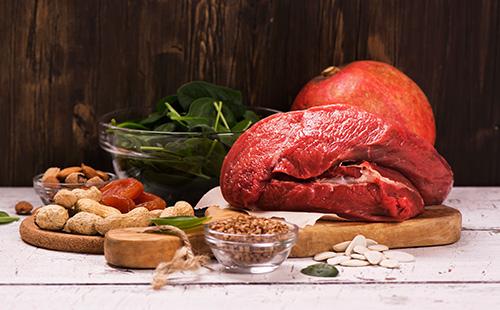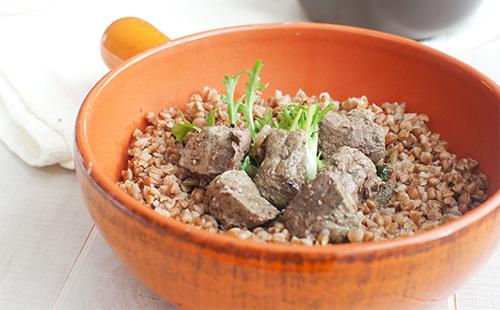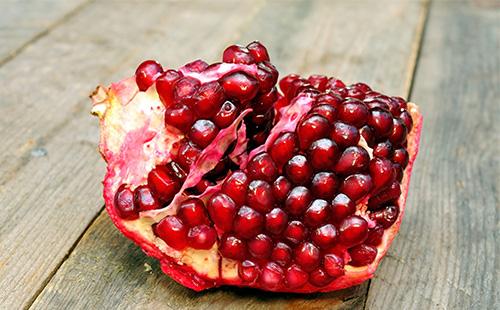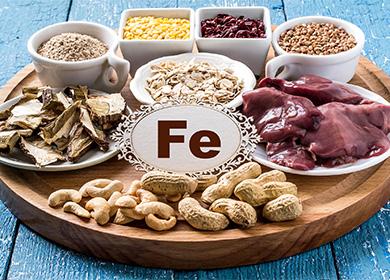The content of the article
Products with the highest iron content are meat, cereals and legumes, but iron is different. This mineral can be of several types: in food of plant origin - non-heme, in animal - heme. The second type is digested twice as easily.
In addition, the valence of iron, two or three, affects the assimilation volume. Ferric iron is converted to ferrous, and only after that participates in the body. Therefore, it is better to use iron-containing products with a divalent value or in combination with ascorbic acid - it accelerates the conversion of valency.
Daily Values for Adults and Babies
Where is iron found and in what products? The daily rate of iron varies depending on gender, age, energy needs and other factors. So, vegetarians need to increase the dose by 1.8-2 times, since vegetables and fruits contain non-heme iron.
Blood donors, women, especially during pregnancy and breastfeeding, need large doses of iron, since a significant part goes with blood, as well as with the development of the fetus and then - the nutrition of the baby.
For children, adolescents and adult men experiencing moderate physical and mental stress, the norm is up to 15 mg per day. The table indicates the approximate level of iron requirements for different groups of people.
Table - Average daily iron intake for children and adults
| Age | Notes | Daily rate |
|---|---|---|
| Children and adolescents under 14 | - With age, the dosage increases | 5-15 mg |
| Women and girls from 18 years to menopause | - With a full diet and moderate physical activity | 20 mg |
| Pregnant and lactating mothers | - Throughout the entire period of pregnancy and lactation | 30 mg |
| Men | - With a full, balanced diet and moderate physical activity | 10-15 mg |
With the following factors, the need for iron increases:
- smoking;
- the use of coffee, tea, cola, alcohol;
- increased physical and mental stress;
- deficiency of vitamins of group B;
- vegetarian diet;
- donation;
- bleeding disorders;
- postoperative periods.
In combination with some elements that weaken the mechanisms of absorption of ferrum, it is necessary to emphasize the menu on foods rich in iron. This is primarily calcium (dairy products) and manganese (almonds, hazelnuts, peanuts, pistachios, coconut, beets, carrots, onions).
But these substances, on the contrary, help the body absorb iron faster:
- B vitamins - cereals, legumes, leafy vegetables;
- vitamin c - citrus fruits, sweet peppers, rosehips, black currants;
- lemon acid - cherries, mountain ash, gooseberries, peaches, plums, tomatoes, black currants;
- routine - citrus fruits, buckwheat, plums, grapes, apricots, garlic;
- succinic acid - aged wines, brown bread.
"Revision" menu: select products containing iron
What products contain iron is no secret. Food containing iron is all kinds of meat, some types of poultry, fish and seafood, individual vegetables and fruits, legumes and cereals. Moreover, if we are talking about animal food, then in different parts of the same product the indicators of the mineral content differ.

Meat, liver and offal
The meat contains heme iron, which is absorbed by 20%. Thus, in order to get 15 mg of iron from meat, it is necessary to eat a portion containing 75 mg of the mineral. Preferably chilled rather than frozen meat, since beneficial substances break down at lower temperatures, less iron remains that the body can absorb. Muscle tissue is not the richest “site”. What meat is better for people with a deficiency of ferrum, can be seen from the table.
Table - Iron content in various types of meat
| Types of meat products | The amount of iron (mg) in 100 g of the finished product |
|---|---|
| Cooked sausage | 1,4-3,5 |
| Rabbit | 3,3 |
| horsemeat | 2,7 |
| Beef | 2,68 |
| Mutton | 2,34 |
| Pork | 1,44 |
| Veal | 0,7 |
Quality sausages also contain iron, but they cannot be considered as a source of mineral. The concentration is too low due to the abundance of flavors and preservatives. The greater the fat content of meat, the less iron. Interestingly, the liver of animals, birds and fish contains much more iron than the pulp, as can be seen from the table.
Table - Iron content in various types of liver
| Types of liver | The amount of iron (mg) in 100 g of the finished product |
|---|---|
| Pork | 20,2 |
| Beef | 6,9 |
| Veal | 5,98 |
| Goose | 3 |
| Cod liver | 1,9 |
Bird
Poultry meat is included in the list of products containing iron, but white meat (chicken, some parts of turkey) contains it in smaller quantities, which is reflected in the table.
Table - Iron content in poultry
| Bird species | The amount of iron (mg) in 100 g of the finished product |
|---|---|
| Goose | 2,83 |
| Duck | 1,9 |
| Turkey | 1,4 |
| Hen | 0,36 |
Obviously, if among the birds to look for products containing iron and increase hemoglobin, it is more profitable to stay on a goose. But keep in mind that because of the high fat content, this bird cannot be attributed to dietary products, which means that the portion should be limited.

Fish and seafood
Fish products are low in fat, so iron is absorbed faster. In addition to fish, the mineral is in kelp, shellfish and other seafood. What to focus on, the table will tell. When calculating the portion, note: sea kale contains iron in a non-heme form, that is, it needs twice as much.
Table - Iron content in fish and seafood
| Seafood Types | The amount of iron (mg) in 100 g of the finished product |
|---|---|
| Mackerel | 1,57 |
| Burbot | 1,15 |
| Squid | 1,1 |
| Horse mackerel | 1,1 |
| Carp | 0,6 |
| Cod | 0,49 |
| Sea kale (dry) | 0,12 |
Vegetables
Vegetables contain iron in a non-heme form. In addition, the mineral content in them, as a rule, is low. Here are just a few examples:
- spinach - 13.51 mg per 100 g;
- cauliflower - 1.4 mg per 100 g;
- carrot - 0.7 mg per 100 g;
- eggplant - 0.4 mg per 100 g.
Suppose vegetables are not suitable as a source of ferrum, but many of them contain vitamins and acids that contribute to its absorption. Use them as a side dish.
Fruits, Dried Fruits, Berries
Dried fruits and berries with respect to iron are much healthier than fresh. But in addition to the mineral, sugar content is increased in dried fruits, so do not abuse it. What fruits to pay attention to, tell the table.
Table - Berries, fruits, high iron drying
| Types of berries, fruits and dried fruits | The amount of iron (mg) in 100 g of product |
|---|---|
| Dried apples | 6 |
| Dogwood | 4,1 |
| Raisins | 3,26 |
| Dried apricots | 3,2 |
| Dried apricots | 3,2 |
| Prunes | 3 |
| Pear | 2,3 |
| The apples | 2,2 |
| Cherry plum | 1,9 |
| Dried pear | 1,8 |
| Cherries | 1,8 |
| Rosehip Fresh | 1,3 |
| Black currant | 1,3 |
| Raspberries | 1,2 |
| Dried dates | 1,02 |
| Watermelon and melon | 1 |
| Gooseberry | 0,8 |
| Blueberries | 0,7 |
| Plum | 0,5 |
| Nectarine | 0,28 |
Legumes
Legumes are one of the richest plant sources of iron, which is confirmed by the following table. But this is non-heme iron. In addition, these cultures contain a large amount of magnesium, which interferes with iron absorption. To regulate this moment, legumes should be eaten with fresh vegetables rich in vitamin C.
Table - Which beans have the most iron
| Bean Species | The amount of iron (mg) in 100 g of the finished product |
|---|---|
| Lentils | 11,8 |
| Soybean | 9,7 |
| Dried peas | 6,8 |
| Beans | 1,5 |
| Green peas | 0,7 |
Cocoa powder also boasts a high ferrum content - in 100 g of cocoa beans 22 mg of trace elements. But chocolate bars or drinks are bad sources of the mineral because they contain sugar. And in the drink, milk is also added, which interferes with the absorption due to calcium.

Cereals, cereals and cereals
Cereals are a sure source of the mineral, as the following table confirms. Traditionally, in order to increase hemoglobin, bran, oatmeal, and buckwheat are used. Due to the content of B vitamins, iron is absorbed faster, but in order to fully satisfy the body’s needs, eat porridge as a side dish for meat dishes. Rice iron is absorbed more slowly, so prefer other types of cereals to it.
Table - Which cereals have the most iron
| Cereals, cereals (cereals) | The amount of iron (mg) in 100 g of the finished product |
|---|---|
| Wheat bran | 14 |
| Oats | 5,5 |
| Wheat | 5,4 |
| Rye | 5,4 |
| Barley (cells, barley) | 3,6 |
| Oatmeal | 3 |
| Millet | 2,7 |
| Buckwheat | 2,2 |
| Rice | 1 |
| Manka | 1 |
Nuts and seeds
Kernels contain non-heme iron. A portion should not exceed one handful per day, since, in addition to a valuable mineral, the products contain hydrocyanic acid and other substances that can lead to poisoning. As can be seen from the following table, hazel is more profitable to eat from nuts and seeds for iron. But this product is seasonal, and you won’t get it everywhere.
Table - Ferrum content in seeds and nuts
| Types of Nuts and Seeds | The amount of iron (mg) in 100 g of product |
|---|---|
| Hazel | 36 |
| Sesame | 16 |
| Poppy | 10 |
| Hazelnut | 4,7 |
| Almond | 3,72 |
| Walnuts | 2,3 |
Mushrooms
Mushrooms are rich in iron, regardless of variety (chanterelles, ceps, thistles), but in a non-heme form. The values are as follows:
- dried - 4.1 mg per 100 g;
- fresh - 0.5-1.3 mg per 100 g.
In some cases, the use of mushrooms should be limited or eliminated. Among the contraindications:
- age up to three years;
- pregnancy and lactation;
- unknown origin of mushrooms.
Milk
Fresh milk and its derivatives also contain iron, and in heme form. But the quantity is insignificant. For example, in 100 g of hard cheese, 0.82 mg per 100 g, and in milk - 0.07 mg per 100 g. At the same time, due to the calcium content, the absorption of the mineral slows down.
Other products
Of the other foods, halva is rich in iron, chicory and yeast (non-heme iron). But because of the additional components (sugar, phytoestrogen), it is better to limit portions so as not to gain excess weight. Below is a table with other products that include this mineral.
Table - Other High Iron Products
| Product | The amount of iron (mg) in 100 g of product |
|---|---|
| Brewer's yeast | 186 |
| Egg yolk | 6,7 |
| Halva tahini | 5,3 |
| Chicory | 4,76 |
| Halva Sunflower | 4,53 |
| Egg | 1,89 |
| Brewer's yeast | 186 |
Ferrum: natural or in tablets
Nutritionists today argue about whether it is possible to compensate for the lack of iron only by correcting nutrition. Indeed, the quality of modern products leaves much to be desired. And to evaluate how many nutrients remain in a particular food after pre-sale processing is difficult.
Nevertheless, gastroenterologists claim that natural substances are still more valuable than similar elements in the composition of drugs. It is from food that the mineral is absorbed by the body best. Therefore, with a decrease in hemoglobin and signs of ferrum deficiency, first of all, review your diet.
For the full assimilation of the mineral, it is necessary to correctly combine meat and vegetable food. Simply put, “bite” steaks with bell peppers, tomatoes and drink citrus or blackcurrant juice. The vitamins C and P (rutin) contained in these vegetables and fruits transform the trivalent form into a divalent one and accelerate the absorption of iron in foods.

